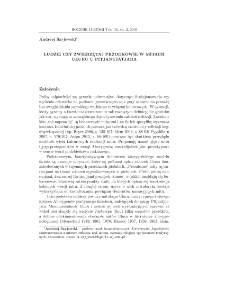Digital Library of Zielona Góra contains 9 272 digital objects
Object
Title: Ludzie czy zwierzęta? Przodkowie w mitach Uluru u Pitjantjatjara = Humans or animals? Ancestors in Pitjantjatjara myths of Uluru
Contributor:
Sapeńko, Roman - red. ; Czeremski, Maciej - red.
Group publication title:
Abstract_pl:
Mity koncentrujące się wokół skały Uluru (Ayers Rock) są ściśle skorelowane z charakterystycznymi elementami jej ukształtowania. Pozwala to na wyprowadzenie szeregu wniosków dotyczącego postrzegania przez Aborygenów przodków mitycznych, zwłaszcza relacji ich strony zwierzęcej i ludzkiej. W przeciwieństwie do istot demonicznych (mamu),takich jak Kurpany, cechujących się zmaksymalizowaną hybrydalnością, przodkowie przejawiają swą podwójną naturę okazjonalnie. ; Ruch odnosi się zwykle do ich zoomorficzności, jednak dysponują jednocześnie cielesnością "ludzką", a zwłaszcza "ludzkim" wyposażeniem kulturowym. Jednak ich przekształcanie w elementy krajobrazu nie zachodzi według jednoznacznego kodu. Szlaki Snu przodków nie wyznaczają syntagmy mitu, ze względu na powtarzanie epizodów w różnych kontekstach geograficznych. ; Przedstawiające epizody mityczne formacje skalne, drzewa i trawa nie mają jednoznacznych przyporządkowań. Tym niemniej przewodnią rolę w tak powstającym amalgamacie tworzą struktury symboliczne rzutowane na elementy krajobrazu, co widać szczególnie na przykładzie obecności binarnej symboliki organizacji społecznej w interpretacjach symetrycznych układów skalnych.
Abstract:
Myths focusing on the Uluru (Ayers Rock) are closely correlated with the characteristic elements of its shape. This allows us to formulate a number of proposals concerning the perception of Aboriginal mythical ancestors, especially their animal versus human characteristics. In contrast to the totally hybrid status of demonic beings (mamu), such as Kurpany, ancestors reveal their ambigous nature rather seldom. ; When moving, they were usually described as zoomorphic beings, but at the same time they were endowed with "human" moods of behaviour, and especially "human" cultural equipment. However, their transformations into the distinctive elements of the Uluru landscape went randomly, without any stable code of transformation. The Dreaming tracks of ancestors also could not provide the syntagm of myth, due to the constant repeating of mythic episodes in different geographical contexts. ; Therefore depicting mythic episodes in rock formations, trees or grass could not offer unabiguous asignments. However, symbolic structures that were projected on the elements of Uluru landscape took the lead in the processes of transformations, what espacially may be observed by the repeatable presence of dual social organization code in the symmetric layout of the rock features.
Publisher:
Zielona Góra: Lubuskie Towarzystwo Naukowe ; Zielona Góra: Uniwersytet Zielonogórski, Wydział Pedagogiki, Psychologii i Socjologii
Format:
Resource Identifier:
Pages:
Source:
Rocznik Lubuski, tom 42, część 2
Language:
Rights:
Biblioteka Uniwersytetu Zielonogórskiego
Object collections:
- Repository > Faculties > Faculty of Education, Psychology and Sociology
- Repository > Types of work > Articles
- Repository > Scientific journals and UZ publishing series > Lubuski Yearbook
Last modified:
May 29, 2024
In our library since:
May 29, 2024
Number of object content hits:
99
All available object's versions:
https://zbc.uz.zgora.pl/repozytorium/publication/89102
Show description in RDF format:
Show description in OAI-PMH format:
Objects Similar
Janicka, Krystyna Frątczak-Müller, Joanna - red. Mielczarek-Żejmo, Anna - red. Szczegóła, Lech - red.
Piotrowska, Anna G. Dudra, Stefan - red. Pochyły, Piotr - red.
Ruszczyńska, Marta Bielniak, Nel - red. nauk. Urban-Podolan, Aleksandra - red. nauk.
Trocha, Bogdan (1963- ) Sapeńko, Roman - red. Czeremski, Maciej - red.
Tichoniuk-Wawrowicz, Ewa Kaczor, Monika - red. nauk. Kładoczny, Piotr - red. nauk.
Ruszczyńska, Marta Kulczycka, Dorota - red. nauk. Ruszczyńska, Marta - red. nauk.
Bernatowicz, Wojciech Kataryńczuk-Mania, Lidia - red. nauk. Mania, Grzegorz - red. nauk.
Draguła, Andrzej Gieba, Kamila (1984 -) - red. Rostkowska-Biszczanik, Kaja - red. Kaczor, Monika - red. nauk. Sztyber, Radosław - red.

